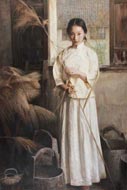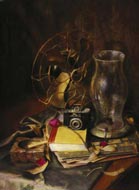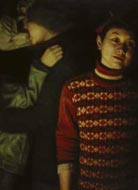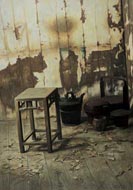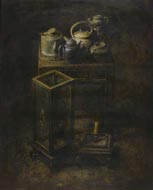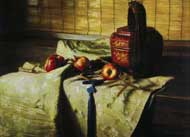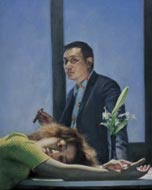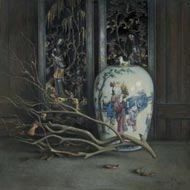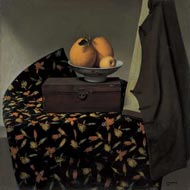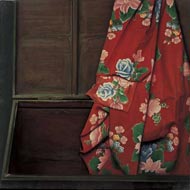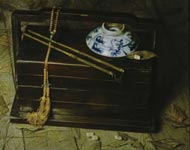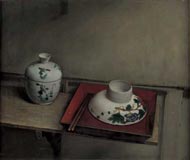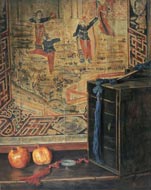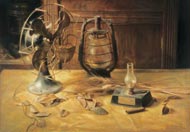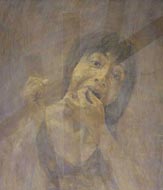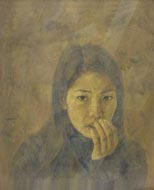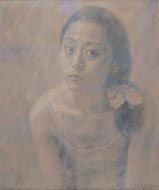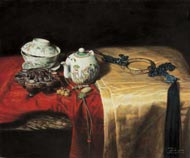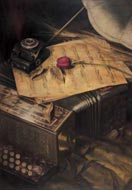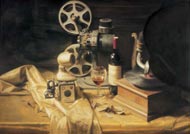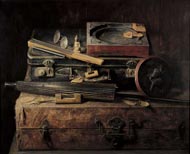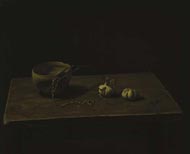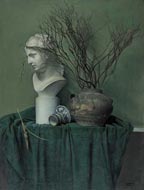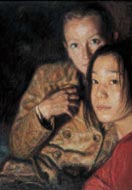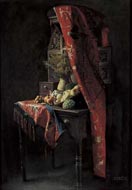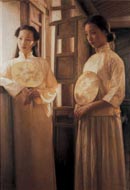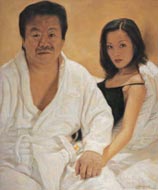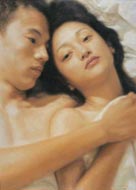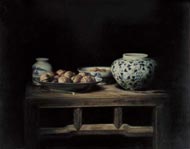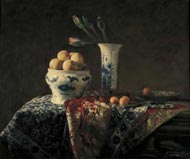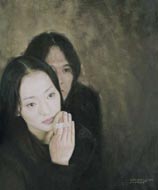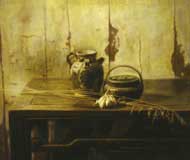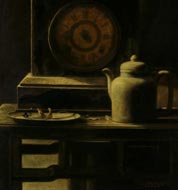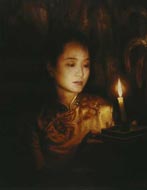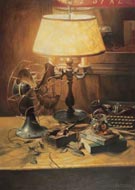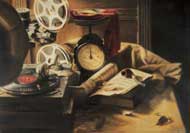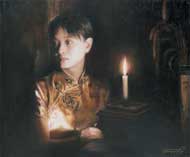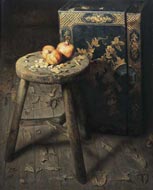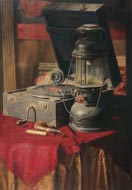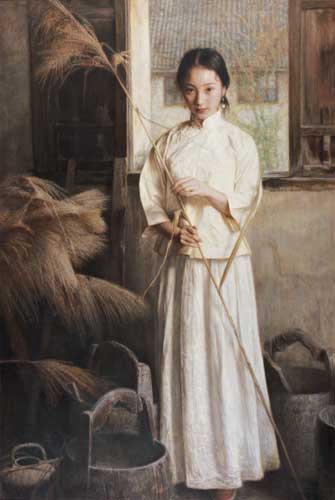
九十年代中期,常青的油画作品已广为人知,在我馆举办的首届上海双年展上,我第一次见到了这位年轻的画家。
当时,常青的绘画风格正在发生着潜移默化的变化,送展的作品也呈现出游移不定的因素。几年过去,我们似乎可以高兴地看到,常青的风格转变已经顺利地完成,一批新作品一改他以往擅长的怀旧情绪,洋溢出非常强烈的时代气息。
无论他曾经已近乎照相写实主义的态度关注着人文历史的遗迹,是昨日世俗生活的光彩再现于精致的作品之中,还是他近来将题材的视角日益倾向于身处的时代,描述更加鲜活的人物、更加新奇的场景,常青无疑是当代中国年轻画家中学院写实主义的重要代表人物之一。而随着新作的问世,他写实技巧也有了显著的调整,色彩愈加亮丽而透明,笔触愈加飘动而轻盈,光影于是也随着情节而愈加显得扑朔迷离。
上海美术馆为常青主办的个人展览就要开幕了,我谨代表上海美术馆对常青表示诚挚的祝贺,祝愿他的艺术探索更上层楼。
上海美术馆 执行馆长 李向阳
2001年12月24日

In the middle 90s, Chang Qing has been well known for his oil paintings. At the First Shanghai Biennial Exhibition held our gallery, I met the young artist for the first time.
At that time, Chang Qing’s painting style was changing gradually. So his paintings on the exhibition also showed some uncertain elements. Several years passed, we are pleased to see that Chang Qing has smoothly completed the style transition in his paintings. A group of new works is full of strong atmosphere of the time, instead of the nostalgia mood he was formerly good at.
Chang Qing is undoubtedly one of the most representative artists of academic realism among Chinese young artists. His achievement include that he had traced the history by photographically realistic attitude, reproduced the past splendid real life in his dedicate works, and recently described the more vivid and fancy scenarios by focusing on the current time. Along with the launch of his new production, he made significant adjustment to his realistic painting skills with brighter and more apparent color and more flaring and light style of brush. The light and shadows are then becoming more complex along with plots development.
Chang Qing Painting Exhibition sponsored by Shanghai Art Museum is going to open. I hereby, on behalf of Shanghai Art Museum, to extend my sincere congratulations to Chang Qing, and wish his art research develops to a new height.
Li Xiangyang
Executing Director of Shanghai Art Museum
2001.12.24
- 回返的“出逃”: 写给常青的作品及他的短信——许江
- Escape of Return: about the Paintings and the Letters of Chang Qing - Xu Jiang
(一)
常青回四川,行前留下一摞照片。照片中有学生时期的习作;有十年来静物画的代表作品;有近几年新画的人物作品;更有最近一个时期我从未见过的纸上作品。照片中夹着一封短信,他匆忙赶往别处,却留下了几行真情道白。他谈到渐近中年对生命的感悟,谈到赶回四川去看望病危的父亲的复杂心情,并说:由于这些变化,心态反而沉稳了许多,反倒感到了认命的坦然,“这是一种出逃的感受”。
“出逃”,这个有几分惊愕的字眼,依稀地在常青微光颤颤的画幅上闪现,将这些作品,这些跨度颇大的作品,一下子串联在了一起。表面上看,“出逃”的感觉与常青许多静物作品的精细制作是颇不相符的,但是当我们面对他这个人、面对他的生活与艺术之间的状态上的复杂现象,以及在他发展路径中被奇特地阐扬着的几个高点,并将之作为一代青年的意识现象来加以审视的时候,便会同意“出逃”这一坦诚的自白。以往常青的画总把我们带到一种对过往岁月的细微体察之中,这一次却向我们指明了宿命的追踪,以及这种追踪之下渴望“出逃”的感受。它划出了一代人的独特的心灵弧线,而那个起始的端点,则是一个少年多敏的内心,是一场关于青春的无名和韶华易逝的敏感之间的无边的追逐。
(二)
认识常青的人,几乎都不去忘记1987年他大学三年级时所画的那张《碗》。那块瓷碗的精到的质感,感动了许多人,并在后来的日子,推动了一个技艺精到的中国静物画派。但是,那悬于画面一隅的孤独、那位于长桌边缘的暗示、以及瓷碗锯痕所隐显的岁月沧桑之感,却开启了静物绘画最感人的一面,是许多同类绘画所远远不及的。
常青这一代人是成长在八五新潮的急骤变化的空间之中。一方面,中国改革开放初期显示出非凡的活力,社会在迅疾地变迁之中;另一方面,八五新潮的试验精神表现出层层叠进的“反绘画”倾向。这些都将一部分青年尤其是美术院校中的青年逼入了一个进退两难的境地,他们感觉到了一种无根的彷徨。于是,与八五新潮浪尖上的前卫倾向的弄潮儿不同,这一批青年向着另外的倾向蝉变。他们从现实生活中出逃,从现实之城出逃,以重返传统的技艺方式,借用带着岁月之痕的器具,向着过往的年代、向逆时针的方向逃匿。逃匿与藏身有关,常青将自己藏匿在一个幽闭的空间中,藏匿在一个“它方”、一个他自己“不在”的空间之中。他描绘逝去时代的器物,描绘落满尘埃的岁月,把自己藏匿在浮荡的微光的深处,在那里打磨昔日韶华的凄艳的回光。
在一个相当长的时间里,常青沉缅于这一类题材。他所画的旧日的器物,有不知是停是行的钟,有打着锯痕的瓷碗,有老风扇、老相机,有旧报纸、旧眼镜,还有鲜果、干果,所有这些器物,都与时间有关。他熟练地使用各种手法,让器物上落满尘埃,用精致的朦胧营造月光如水一般的弥漫,用微黄的灯光照亮旧日铅华的风采。他着迷地利用道具的台词,描述“人”的隐密的行踪,叙说缺席者的寓言。岁月在这里变成具体的物,而韶华的余韵和陨落,则不断地勾起人们隐密的心绪和生命的感伤。常青几乎达到了古典静物画难以达到的境域,同时,也让自己的“出逃”落入了一口寓义性绘画的深井之中。
(三)
八十年代中期,常青从开放的空间出逃,向着隐密角落、向着自己不在的“它方”自我放逐。他仿佛一部老相机,在一片曝光稍显不足的暗室中,用慢镜头摄下一段一个世纪之前的时光,或者说,摄下被一个世纪所遗忘的时光。弥散的光,带着幽暗的挑逗,在遗忘被唤醒的那一瞬间悄然显象。作为形相,这些器物在黑暗和幽闭中已经存在了很久,现在它突然被照亮,被生活的无名照亮,被“出逃”的本意所照亮。被照亮的不仅是这些器物,而且是器物被遗忘的本身。
96年第一届上海双年展前后,常青开始关注身边的人。他仿佛从器物被遗忘的揭示之中清醒过来,开始从那个深井之中向着真实生活的层面回溯,从他刻意营造的“静物”空间中回到生活的周遭。他画了一批批不同的人物,并让这些人物在水洗的痕迹中静静地退色,却表现出不甘的无奈。就象他的静物中充满着“缺席者”的痕迹一样,这些肖像画总给人一种异样的故事感。画中的人物仿佛处于刚刚被照亮的那一瞬间,还没来得及从迷茫的木然中清醒过来。常青最近画的一系列双人组合的作品,以微暖的黄光,提出性感的暗示。那些弥散着病态的挑逗气息,那种俩人情的暧昧之感,仿佛被某个冒失的闯入者激活,变得格外撩人,格外纠缠,那奇特的困顿和迷茫,似幻似真,被朦胧的微光照亮。
常青没能完全改变这个幽闭的空间,但是,他动起来了。他的笔、他的眼睛流动起来了,他的画流动起来了,他的真实感随着微光轻轻流动。他渴望与文学涵意、与象征寓意、与照片般的晕光效果拉开距离。一方面,正是这些精当描绘的寓意空间,开启了他的某种超验的生命之感,另一方面,这种精当描绘以及可能带来的媚俗倾向,又令天生敏感的常青感到厌弃和无奈。他渴望着从这个“出逃地”出逃,他继续逃向“它方”。
在这里,常青再一次表现出刻划的精微,同时又添加了捕捉的敏锐,对韶华易逝的敏感变成了对生命的留恋和直观。留恋使他的表现更为缠绵,而直观又使缠绵变得大胆而直白。我们似乎隔着厚厚的磨砂玻璃,窥望着只属于两个人的隐密的空间:苍白的面孔,惊悸的手,脂粉的气息,……,这些人物更象是一些影子,在上面飘荡着惊悸和无奈的眼神,这种眼神比藉里柯笔下的僧众那带泪的眼神更无望,同时又添加入鱼目一般的木然。我们仿佛不是“看”到这些人物,而是由于朦胧的暖黄的色调,感觉到某种正在发生的故事。这种朦胧的“亲历”之感,让我们来不及看清这一切,就已经为朦胧本身、暧昧本身所经验。常青曾经用布满灰尘的精当的器物,点亮我们某些幽闭的心事,现在又用风尘中的朦胧人物,把我们塑造成“闯入者”,在那里体验某种奇特的经历和想象。
(四)
“动”起来的常青继续着他的“出逃”。正如他的信中所说:“大概是人到中年之故,对生命和艺术以及许多事物的认识都深入了些,心态沉稳了许多,作品反倒轻松了。在成都看着那个给了我生命的男人的痛苦挣扎,我开始留恋身边的人和事,珍惜体内的温度。”“不知您有没发现我比一般的人更喜欢涂鸦,这缘于我好动的天性,我喜欢我的感性对理性的摆脱,这是一种出逃的感受。”正是这个给“他生命的人”的生命挣扎的过程,正是不住地往返于杭州成都,如此近距离地体察此次与它方、生命与死亡,使他从心底里渴盼解放,渴盼一种认命的率真,并把它痛快淋漓地表现在纸上,于是他从老古玩店来到隔壁卡拉OK包厢,现在,他终于来到了街口,他感受到了真实的“出逃”的感觉。
最近的一段时间,常青画了大量纸上作品,碎片般地记录生活中的片断,非常直接地描述各种众生之相。这些速写如此生动,令我想起80年代中期,当常青还是一个大二学生的时候,他的速写就曾经引起我的关注。现在,他经历了十多年的“出逃”,又回生活的周遭,仍然是那样机敏的观察,但多了挑逗性的神情,多了信手而来的涂鸦。无论“婴儿”的系列,还是《卡那酒吧》、《星期五下午》等真实的空间,都带着现象般的记述,带着直面的率真。《阿郎和我在水中》又象绘画日记,又象不断变化角度的观察和自察。这些描绘,从各个角度、各个时间段连缀起一个丰繁而又不定的现象。我们已经不是在“看”这些速写,而是通过这些重复而又跳跃的片断,来感觉生命变换不居的过程。或者说,这些速写本身正在形成某种发生之事,它企图用无数个匆匆一瞥构成我们对事物、对生命的观看本身。
常青仿佛从一个遥远的端点返回。他一路“出逃”,寻找“它方”,却不期望地回返自己的生活环境。这个路径画了一道弧,从那个自我放逐的隐闭空间向着生活的片面回溯,走回了真实生活的周遭。“它方”就在我们身旁,就在我们的生存之地。“出逃”的意义并不在于藏匿,而在于“出逃”本身,在于它使生命永远在路上。正是“出逃”,使常青发现了那个隐秘空间的精微和寓意,也使他从那里得以揭开朦胧人群的迷茫和暧昧,现在常青已经站在了街口,“敢问路在何方,路在脚下!”
也许生命的本意正在于“出逃”。
许江
2001年12月下旬于北京饭店
(1)
When Chang Qing went back Sichuan, he left a pile of photographs to me, which include the study drawings in school, his typical paintings of still life, portraits work finished in recent years, and most recent on-paper works that I have never seen. There is also a letter among the photos, which represents what he was sincerely thinking about in the bottom of his heart when he hurried to leave. In the letter, he talked about the sentiment to life in his middle age and his complex mood on his way back to Sichuan to look in his terminally sick father. He also said in his letter that due to these changes, he felt steadier and calmer in his mood, and understood the unperturbed status of fatalism. “It is a sort of escape.”
ESCAPE, a word of astonishment, seems to flash in the glimmering paintings of Chang Qing, and connect his works of wide span together. On the surface, the feeling of escape is quite different from the elaboration of his still life works. However, when we look into the ever person, the complex status of his life and arts, and the several miraculous peaks in his career, when we further evaluate it as an ideology of younger generation, we will agree on his honest confession of escape. Formerly, Chang Qing’s works always lead us to a subtle observation on the past years. Now that they turned to express the pursuit of fate and the desire of escape related to such pursuit, and drew a particular curve of soul for the generation, the starting point of which is the sensitive heart of a young man and also the endless chase for confused youth and elapsing time.
(2)
Almost all the persons know Chang Qing can not forget his painting, Bowl, which was drawn in 1987 when he was a junior student in college. The refine texture of the ceramic bowl had moved many people, and thereafter, promoted the development of Chinese still life painting style with delicate skills. Moreover, the painting represents loneliness by suspending the objective to the corner of the picture, the implication of the location on the edge of the table, and the feeling of history and change hinted by the kerf on the bowl. All of these turned on the most moving leaf of still life that is far ahead of most similar paintings.
The generation of Chang Qings has grown in the dynamic changes of 85 Wave. On one hand, the initial stage of reform and opening-up of the country brought extraordinary energy, which rapidly changed the society; on the other hand, the experience spirit of 85 Wave represented increasing trend of anti-painting. Both had cornered part of young people, especially the students in fine art colleges, into a dilemma, making them oscillated. Therefore, unlike the pioneers in the 85 Wave, they changed to some other direction. They escape from the realistic life and from the city of reality to the past in the anti-clockwise direction with traditional skills and tools with trails of time. Escape is relative to hiding. Chang Qing has hidden in a sealed space, in “other where”, and in a place where he does not exist. He paints the tools and articles of the past, hides himself in the depth of the lingering glimmering, refining the loneliness and beauties that belong to the past time.
During a long period of time, Chang Qing has been indulged in this kind of themes. The old tools and articles he painted, including the inactive or running clock, ceramic bowl with kerf, old wind fan, old camera, old newspaper, old eye glasses, fresh fruit or dry fruit, were all related to time. He skillfully employed various methods to make the articles covered with dusts, to make alive waterlike spread moonlight, to lighten the past elegance with yellowish light. He was obsessed to describe the mystery trace of the “people” and explain the fable of the absent with the word of the property. The time changed to be the specific articles here; while the aftertaste and falling of the splendid past constantly reminds people of their secrete mood and sentiment to life. Chang Qing almost reached a point that classic still life can not reach, and meanwhile, let his own escape falling into a deep well of allegoric art.
(3)
In the middle 1980s, Chang Qing escaped from the open space to the secrete corner and exiled himself to the Other Where he does not exist. He is like an old camera, shooting with slow motion a period of time one-century before or the forgotten time by the century in an underexposure darkroom. The dispersed light with gloom flirtation silently appeared at the wake of the memories. As images, the articles had been existing in the darkness and incarceration for a long time. Now they are suddenly lighted by the unnamed light of life and the meaning of Escape, which not only light these articles, but also light the ignorance itself.
Since the first biennial exhibition 1996 in Shanghai, Chang Qing has begun to pay attention to the people around. He seemed to wake up by the hint of ignorance, and began to return from the deep well to the reality, from the space full of still life he elaborated to the life around. He painted many various people, making them quietly fading in the trail of water wash to represent the helplessness that not willing to give up. The portrait works display an abnormal story-like style, just as his still life works which are full of the trails of the absent. The figure in the portrait seems to fail to wake up in the vacant just as if at the ever moment he or she was lightened. In the series of double-figure paintings Chang Qing recently finished, the warm yellowish light gave the sexual hint. The diseased flirtation flare and the ambiguous atmosphere of lovers, as if to be activated by a rude intruder, became utmost jiggly and tangly. The fancy confusion and perplexing is lightened by the faint glimmer.
Chang Qing failed to change this incarcerate place. But he became moving. His brush, his eyes and his paintings became flowing. His sense of reality also became flowing with the gleam. He desired to withdraw the distance with literature implication, with symbolism, and with the photo-like halation. On one hand, it is the elaborated implication that exposed him of the extramundane sense of life; on the other hand, the subtle drawing and the indecent preference that may brought about herewith made him feel disgusting and helpless. So he desired to escape from this fleeing place to “some other where”.
At this stage, Chang Qing again shows his delicacy of drawing. In addition to this, he also shows the acumen of capturing and observation. The sentiment to the elapsing splendid time became nostalgia and confrontation of life. The nostalgia made him more sentimental, while confrontation made the sentiment to be more fearless and honest. As if we are peeking the secrete space of the lovers through thick ground glass: pale faces, shaking hand, cosmetic flavor… The figures are more like shadows with horrified and helpless eye expression. Such eye expression is more helpless than the teary eye expression of Seng Zhong written by JILIKE, with vagueness of fish eyes. It seems to us that we are “seeing” these people, instead, we are feeling about the incoming stories due to the vague warm yellowish tone. The vague sense of experience distracts us from everything before we experienced the vagueness itself. Chang Qing had lightened our incarcerated heart with dusty exquisite articles. Now he made us to be the intruders, experiencing the special and amazing imagination with the vague figures.
(4)
The “moving” Chang Qing continued with his escape. Just as his word in the letter: “ May be due to the middle age, my understanding to life and art and many other things became more profound. And my mood became steadier and calmer, which in turn made my works more relax. Since I witnessed the painful struggle made by the man who gave me the life in Chengdu, I began to sentimentally attach the people and things around me and to cherish the temperature inside my body.” “Have you found that I am more fond of doodling than other people, which resulted from my nature of activity. What I love is that my sensibility break away from my rational knowledge, a sense of escape.” It is the life struggle of the man who gave his life and the frequent journey between Hangzhou and Chengdu that made him closely observe the concept of This Time and Other Where, Life and Death. Such experience also brought to him the desire of release and the desire of honesty for fate. Then Chang Qing tried to describe all these in his paintings. So he goes from the antique store to the Kara OK entertainment next door, and finally to the street cross with the feeling of real “escape”.
Recently, Chang Qing worked out many paintings, recording the fragment of life and directly describing the life of the mass. The sketches are so vivid that reminds me that in mid 80s when Chang Qing is a junior college student, his sketches had drawn my attention already. Now when he returned to the life around after over ten years’ escape, his observation is still so acute. The difference is that the flirting expression and casual doodling are added in his painting. The real spaces including the series of newborn, Kara Bar, and Friday Afternoon, etc. all have scenery statement and confronting frankness. The painting named Aran and I in the water seems to be a drawing diary or observation and self-examination from constantly changed directions. Such description connected a rich and changeable phenomenon from different angles in different time span. Instead of “looking” at these sketches, we are feeling the changing process of life by the overlap and incontinuous fragment. Or, the sketches themselves are forming some coming fate, trying to compose the observation to things and life with numerous glimpses.
Chang Qing seems to return from a remote port. He kept escaping and seeking for the “other where”, but unexpectedly returned his own circumstance. His path turned around from the incarcerated space of exile to the retrospect to the life, and eventually to the realistic life. The “Other Where” is just around us in the place where we live. The meaning of escape does not lie in the “hiding”, but the “escape” itself and the drive making the life always on the way. It is “escape” that unveiled Chang Qing of the delicacy and emblem of the incarcerated space and made him expose the confusion and ambiguity among the mass. Now Chang Qing is at the cross of road. “His road is just under his foot.”
Maybe the meaning of life lies in the “escape”.
Xu Jiang
Beijing Hotel
2001.12.
- 穿裙子的假女子——彭德
- A False Woman in Skirt - Peng De
单刀直入
两年前,常青请我写评论,我说:“我关注的是前卫艺术,我写你,我的角色会变得暧昧。”常青说:“你关注的不是艺术,而是艺术之外的东西。比如一幅画面上有一堆玻璃渣和一只高跟鞋,你肯定会产生兴趣:有人跳楼了!谋杀还是自杀?为了钱还是为了爱?你会近一步发挥:市场经济的出现使人生变得脆弱,现代化的高楼变成了现代人的刑场,等等等等。你还可以用一些观念或主义加以界定。这是我在大学二年级时的一件作品,但很快就放弃了。我发觉这种构思太戏剧化。人生毕竟不在剧场,生活中使人刺激的东西毕竟是少见的和反常的。我认为好的艺术应该平实自然。我对刺激人的景象有一种恐惧感,比如马路上有一只被汽车压得血淋淋的猫,来往的汽车继续压过去,弄得血肉模糊,有的画家可能马上凑过去打量,认定是一幅难得的题材,而我却会绕道而行,躲得远远的。”常青说这番话时,声调高亢快捷,拒绝插话,有百分之五的词语轻度结巴,同时调动手、颈、眉、眼以及嘴唇和鼻子周围的肌肉参与表达,总体效果如同一群汽车压一只猫一样,让从事批评的本人肝胆俱裂。
假女子
常青家有一张60年代在成都拍摄的全家福:母亲和二男一女。女孩年方3岁,丫丫辫加裙子,秀气的脸庞上撅着一张嘴。这女孩排行老二,名叫常青。常青是远近闻名的假姑娘,成都人叫“假女子”。常青母亲渴望生一女儿,偏偏生的都是男孩,见常青秀气,便将他男扮女装以饱眼福。殊不知这种特殊的溺爱,使常青的角色错位并在以后的岁月中变相地延续,进而有可能影响他的一生。
常青从小对他的假象进行了不懈的反抗:解辫子、扯裙子、撕相片。母亲按照自己的趣味,不懈的进行规劝,指出辫子和裙子无比地好看。每有大人都围着他逗乐,常青便掀开不穿内裤的裙子巡回展览,昭示自己的真相,或许就是为了从心底洗刷自己的不白之身。常青后来在美院附中时,率先早恋,说话嗓门粗壮,不蓄长发。不过常青的仕女画,一律穿着裙子或长袍,一层层遮得严严实实,人物姿态和神情也毫无挑逗的意味。常青的人体习作十分精到,一旦创作则绝不裸露。
坏学生
15岁时,常青考入四川美院附中,期间先后八次被学校报请教育厅开除学籍。罪状有两条,一是酗酒闹事;一是一贯性的目中无人,声称只有伦勃朗和米开朗基罗才会画画,学校于是认定该生不可救药。常青回忆这段不幸经历时,坚持说目中无人的传言是栽赃,但当时所有的人都认为只有常青才能对此口吐狂言。
开除常青的请示报告每次上交后都被驳回,因为教育厅的当事人同常青是邻居,认定这假女子从小天真无邪,不可能突然变得如此嚣张。不过除名的厄运并未就此中止。1984年,常青考入中央美院,学院根据四川美院提供的材料将常青除名。可见假女子擅自掀开裙子,就将付出沉重的代价。好在常青在艺术上有着顽强的生命力,否则这位右派的儿子便永远无缘进入画坛。
种瓜得豆
1985年,常青考入浙江美院油画系。按美院传统,素描必须用铅笔。在常青的心目中,这种规定同让男孩穿裙子一样武断。常青坚持不用铅笔,入学两年间,速写和素描通通用的是毛笔、钢笔和圆珠笔,他想画出打破规则的效果。常青喜欢画图画日记,如《晕船》,用毛笔描绘油画系师生在写生途中晕船的全过程,造型滑稽有趣。常青的漫画多神来之笔,同学争相请他画像。他还画过未来的夫人的漫画,将娇小美貌的本相画成各类鬼脸,有的像精怪,有的想夜叉,有的像巫婆,奇丑无比,惨不忍睹。
时值中国前卫艺术的高峰期,常青画了一系列小幅变形人物画,形象与画法奇特,被视为前卫坯子。1987年,浙美教务长视察学生画室,见到一幅狂放的抽象变形习作,一打听,作者是常青。常青当时学的是日本现代画家栋方志功的画法,这种画法很容易被视为背离学院派的坏画。第二天,教务长带人去拍摄这件作品,作为不良倾向予以披露以正学风。张自嶷得知这一消息后,立即找到常青,让他连夜赶制一幅写实的素描。第二天,教务长率领一群人来到画室,面对的竟是一幅扎实而潇洒的传统素描作品,一打听,作者是常青。这也是常青入学后唯一的一件铅笔画。
1987年的中国首届油画展,常青的参展作品是一幅画在红色八仙桌上的瓷碗。老师曾告诫他们,静物画不能出大作。这个结论调动了常青偏要用写实画法画静物的激情。这是一种常见的素材,但却没有人去画,他感到很奇怪。使他更奇怪的是这幅画引起广泛关注,以致从此他被人牢牢的定格在这幅偶然为之的习作的风格上。在浙美预展期间,前院长莫朴用拐杖敲着常青的画框对油画系的师生们说:“什么是艺术?这就是艺术!”常青的瓷碗问世,摹仿者蜂起,俨然形成了一个没有组织的瓷碗画派,很快占领市场,卖价甚高。人们戏称常青是中国油画届奔小康的带头人。
前卫人生
常青不是前卫艺术家,但却是一件活生生的前卫作品。他向往艺术化的人生或人生的艺术化,认为懂得生活的人才懂得艺术。他认为有的名家在这一点上还没有开窍。
前几年,方力钧等人经常南下杭州,一律的光头亮如灯泡。奔小康的带头人正是这一行人拜访的人物之一。他们同常青一起打牌玩耍,闭口不谈艺术,或者说闭口不提裙子,吹牛只涉俗人俗事,奇谈怪论,俚语笑话。
在一个群体中,常青是不会使人生厌的人。他说话妙语连珠,评议人物无所顾及,即使不小心放出狂言,也能迅速修正,套上裙子。有的画家作品惊人,为人却十分含蓄;有的画家作品古典,为人却风流倜傥。常青显然属于后者。在亦步亦趋成风的中国艺坛,应该容许常青的天性自然成长,不要迫使他们别别扭扭地穿上裙子。反过来,象已经习惯于在艺术上穿上裙子的常青,人们也没有必要加以否定。
人类的价值观常常南辕北辙。比如中非的一些国家曾经禁止女人穿裤子,认为开叉的裤子太性感。果不其然,一旦开禁,那爱滋病的蔓延就如同暴风骤雨一般迅猛。三千年前,周朝帝王奖赏功臣的最高级的物品之一,就是朱红色的裙子,并在三百多年的和平发展时期形成惯例。在穷兵赎武的当代世界,在文明的进程总是是仰仗暴力的思维模式阴魂不散的今天,人类是不是到了统统都该穿穿裙子的时代?
写实画法
常青画的一些写实油画作品如旧式梳妆台、椅子、灶台、皮箱、杂物等等,画面一律深沉压抑,一片片枯叶象征性地散落在周边,强化着画面的情调。或许是为了同高级行画拉开距离,他的人物画大都具有相同的作风。人物的神情忧郁,体态凝固,道具陈旧,背景阴森。这种作风对于常青,是在精神上撕裙子的表现,但无意中却满足了大龄富豪们对家史或初恋的回忆。常青不厌其烦的描述中国文明史上这个穿裙子的时代,同他的年龄与生活方式确实有着天壤之别。
常青的瓷碗与仕女,完成的效果不腻、不板,交界线处理的松动自然,具有油画味。常青特别推崇委拉斯贵支用笔随意但却恰倒好处的技法,认为中国还没有一人达到其水平,言下之意潜藏着有朝一日同委氏一争高低的意图。
1999年,常青画了一幅两年轻女子的半身像。正面女子的原型是杭州越剧团的花旦,侧面是浙江歌舞团的演员。常青在院长的陪同下,像宫廷选妃一样逐一挑选,挑中者并不十分漂亮,但很入画。常青随即将她们带到选定的房子中,让她们穿上裙子,构成各种双人照组合,拍了十来卷135彩照。每种组合都有细微的变化,照片洗出后寻找一些好的局部加以组织,定稿的画面是强调窗内人物身上的环绕光,是恬静的画面焕发出生气。作品涂色采用层层覆盖的方法,面部画了近20遍,一遍冷调子,一遍暖调子,每一遍都要注重大调子中的微妙变化。最后几遍用中间调子画。
艺术观
常青认为现代传媒助长着画坛的投机主义思想。一部90分钟的影视片,足以描述美术大师的成名史,这种浓缩的人生使当代画坛变得急于求成而热衷于投机取巧。有的投政治的机,有的投老外的机,有的投理论家的机。常青认为自己在画坛上也是一个投机分子,只是同其他投机者的倾向不同而已。
常青认为在中国最容易成功的是当代艺术,趁中外信息还不大畅通之机,通过画册或展览,抢先将西方某个名家的风格进行复制或改装,用中国人的手,画西方人的画,但这类画家在画史上没有意义。常青当着我的面数落前卫艺术,与其说旨在改变我的视野,不如说是提醒批评应该平等地对待各种艺术倾向。由于我认为若干年后,画坛将会出现第三势力,即艺术绿党。常青说他对一些前卫画家的担心也是对自己的担心。他自己的好奇心很重,抵挡不住时尚的诱惑,于是想在前卫艺术作为时代先锋的时候保持距离,做自己想做的和能做的事。他说他目前的理想是找西方艺术大师的缺点去加以弥补,使作品画的完美。不过常青末了又用困惑的语气说:“艺术家似乎应该是病态的,我的画是不是太健康了?”
来日方长
人生的经历是人生目标的手段,手段的成功往往会给当事人带来市俗的利益,手段因而常常被转变成为目的,从而自己将自己定死。常青在商业的层面上早已获得成功,但在艺术上最终能否成大器,首先在于他能否从心底排除市俗的诱惑,这将是他的艺术事业中的一个生死劫。
Directness
Chang Qing asked me to write critique on him two years ago, but I said, “ what I am focusing on is the advance guard. If I commented on you, my identity would be blurred. ” Chang Qing was in a loud voice “No, you are focusing on other things instead of art itself. Take a picture for example, on which there is a pile of broken glass and a high-heeled shoe, you must be very interested in it. And you would think ‘Someone is jumping from the top! Is it a murder or suicide? For the sake of money or love?’ Then you would continue thinking ‘ The market economy makes people weaker and the modern high buildings have become an up-to-date execution ground etc.’ you would also define it with some concepts or –isms. That picture is my production when I was a sophomore. But I gave it up soon because I found such design is too theatrical. After all life is not in the theater and stimulators, which are abnormal and infrequent. I think good art should be natural. In fact I have a sense of trepidation when seeing those scenes. For instance a cat run over by an automobile, passing automobiles still run over it and make it gory. Maybe some artists would join and think this is a fantastic theme. But I would bypass it.” He even didn’t give me any chances of interruptions and 5% of his words were in a bit stammer. He was not only using the mouth to say it but also hand, neck, brows, eyes and muscles nearby his lips and nose. All this smashed me into pieces just like the gory cat.
A False Woman
There is a photograph of the whole family in Chang Qing’s home taken in 60’s. In the photo there are mother, two sons and one “daughter”. This only girl was three years old, wearing braids and a skirt, with a delicate face but she pursed her lips up showing the angry. This girl was the second child of the family, named Chang Qing, who is a famous false girl. Chang Qing’s mother was eager to have a daughter but all her children are boys. Chang Qing has the prettiest face among the three so she dressed him as a girl to fulfill her dream. But such way of doing mixed his gender up and affected his life even life long.
Chang Qing resisted such dressing in childhood. He broke the plaits up, tore the skirt and photos. But mother always thought plaits and skirts were very beautiful. And everyday adults teased him. Chang Qing just raised his skirt to show the inside (without underwear) to tell all the truth. In order to show he is a male, Chang Qing was the first to fall in love in middle school. He had rasping voice, no long hair. Nevertheless beauties drawn by Chang Qing are always wearing skirts or long gowns. There is not any flirtation in posture or mien. His model drawing is excellent without nudity.
Bad Student
Chang Qing was accepted by the middle school attached to Si Chuan Academy of Fine Arts at the age of 15. The school applied for the Education Department to dismiss him for all together eight times. One cause is that he got drunk and made troubles. The other one is that he was overweening, claiming only Rembrandt and Michelangelo know arts. The school thought all his faults couldn’t be forgiven. When he recalls it, he insists that it was not true. But at that time all the people thought only Chang Qing could say so.
The application reports for dismissing Chang Qing were always turned down because the head of the Education Department was Chang Qing’s neighbor and thought this false girl was so innocent that he would not become so overweening. In 1984, the Central Academy of Fine Arts admitted Chang Qing, but the institute dismissed him according to the reports provided by Si Chuan Academy of Fine Arts. This false woman made bold to raise his skirt and then he was cost a lot due to his boldness. Fortunately Chang Qing is persistent in arts, otherwise Chang Qing, the son of a righty would have never entered into this field.
Arduous Endeavors
In 1985 Chang Qing was accepted by Oil Painting of Zhejiang Academy of Fine Arts. The academy’s tradition is to sketch by pencils. But Chang Qing thought such tradition is as opinionated as to let boys in skirts. He just wanted to break this tradition and used pens, ball pens and brush pens. Chang Qing likes drawing diaries. He once drew “nausea” by brush pen to describe that once students in the Oil Painting Department had the nausea on the way to sketch. The forming is quite funny. So classmates all strived to let him draw portraits for them. He drew many cartoons of his wife. He drew the pretty girls into the forming of various grimaces, some like a spirit, some like a demon and others like a witch. All were very ugly and gloomy.
During the fastigium of Chinese advance guard arts, Chang Qing drew a series of transformed figures in small size. The image and brushwork was so strange that he was regarded as an advance guard. In 1987 the head of Education Administration Department in Zhe Jiang Arts Academy saw an unruly transformation painting by Chang Qing in the students’ studio. At that time Chang Qing was studying the brushwork of a modern Japanese painter. Such brushwork was regarded bad as it was against academism. The next day the dean distributed a guy to take a photo and expose it. Mr. Zhang Ziyi told Chang Qing as soon as he got the news and let him draw a true-life sketch overnight. The next day when the dean came to the studio he found a nice traditional sketch drawn by Chang Qing. This is the only sketch that Chang Qing drawn by pencil.
On the First Chinese Oil Painting Show in 1987, Chang Qing’s product was a picture of a porcelain step painted on a red traditional Chinese table. His teacher warned that a still life could never be a piece of great work. But such a conclusion just aroused his rebelling spirit. He thought it was strange that nobody draw it and what made him feel more strange is that his painting attracted so much attention. Even later such a painting he drew by chance was regarded as his style. The former dean pointed his painting with his stick and said to the students of Oil Painting Department “ What is art? THIS IS!” After that many people followed this style and an unorganized Porcelain Step Faction came into being and soon dominated the market. Furthermore price of pictures of this style is high. People said Chang Qing led the Chinese Oil painters to be well off.
Advance Guard in Life
Chang Qing is not an advance guard artist but a piece of advanced guard work. He yearns towards artistic life and thinks only people who know life can know arts well. And some artists are not clear about this point.
Years ago Fang Lijun and other people often went to Hang Zhou, bareheaded. They visited Chang Qing, who led the Chinese Oil painters to be well off. They chatted and played together, while never talking about art. Even when they were bragging, their topics were confined to common things, jokes.
In the group Chang Qing would never let you feel tired. In his mind there were no prohibited topics. He would immediately cover it up with a skirt when he unconsciously said any sensitive topics. Some artists’ works are explicit while the artists themselves are implicit; some artists’ works are classic while they themselves are modern. Chang Qing is definitely the latter. In today’s Chinese arts, imitations are dominant. But Chang Qing should be allowed to grow up freely. We shouldn’t force him to wear a skirt. Likewise we needn’t criticize Chang Qing, who is used to wear a skirt in arts.
People’s value orientation is often contradictory, for instance in central Africa some countries have prohibited women to wear trousers, as they look sexual. As expected AIDS spread apace when the ban was lifted. Three thousand years ago the greatest prize Emperor in Zhou Dynasty gave to his servants was a vermeil skirt. In today’s world culture development is always along with violence. Should human being all dress in skirts?
True-life Style
True-lifes drawn by Chang Qing contains old styled dressers, chairs, ovens, luggage etc. The pictures all look very gloomy, with yellow leaves scattered all around. Models in his pictures are gloomy, furniture old and the setting bleak. For Chang Qing such style is to show his rebellious spirit in arts. But for some senior rich people this style happens to remind them of their family history and first love. Chang Qing frequently draws the period of dressing traditional skirts in Chinese Cultural History, which is contradictory to his age and life style.
Chang Qing’s porcelain step and beauty are natural, vivid, with the sense of oil painting. He admires Velazquez very much; whose style is casual but just right. Chang Qing thinks there is nobody can compete with Velazquez in China. These words implicate that he intends to exceed Velazquez someday.
In 1999 Chang Qing drew a half-length of two young ladies. The model of the full-face woman is an actress from Hang Zhou Yue Shaoxing Opera Troupe. The side-face woman is from Zhe Jiang Dancing and Singing Troupe. With accompany of the deans, Chang Qing selected his models very carefully. Maybe the models are not very beautiful but photogenic. Then he led them to a prearranged house and let them dress in skirts. They posed and took many 135 colored photos. Each forming has a subtle difference so after developing he found the good parts from those photos and organized into one. After seeing the picture, what impressed you most is the light surrounding the two characters. The author drew the faces for almost 20 times, with cold color and warm color in turns. So you can see the subtle differences in color. For the last several times the author used middle color.
Art View
Chang Qing thinks modern media support speculation in arts. A film of 90 minutes can describe an artist’s history completely. So many painters speculate. Some cater to politics taste, some to foreigners, others to theorists. Chang Qing supposes that he is also an opportunist but his inclination is different from others.
He supposes contemporary arts can easily bring people successes. Nowadays the communication between east and west is not very free, painters can imitate or slightly alter some western renowned artists and then launch a painting show or release a picture album. But only imitation is of no value in arts. Chang Qing often criticized contemporary arts before me. His aim is not only to expand my view but also to remind me that criticism should be fair to all kinds of tendencies in arts. I think years later there will be a third group in arts, that is Green Party. He worries about some advance guards and he also worries about himself. He is very curious and thinks fashion is hard to resist. So he wants to keep the distance from advance guards so as to get more freedom to do what he wants to do. Then what does he want to do? What he wants to do is to make up western artists’ shortcomings and better his own paintings. But at last he asked me in a baffling voice “Arts all appears to be morbid. Are my paintings too healthy?”
Ample time in future
Life experience is a method to life aim. Such successes usually can bring material successes to people. So the method is frequently changed to the ultimate aim and confines one to death. Chang Qing has achieved successes in commerce, but can he be a great artist? I think he should first expel the material temptations from his heart and this will be a big obstacle to him.
- 常青自述
- Readme
我生来就喜欢画画,喜欢表达和倾诉,喜欢独立的角度和观点。学院式的技术和思维训练,改变了我涂鸦和幻想的初衷,我的才能被分解、整理和包装。我曾把有关绘画所有经得起分析的东西都拿出来分析,诸如光、色、空间、质感、体感、材料、画派和美术史……绘画于我时而是一门手艺,时而又是一门科学。我们分析别人,分析自己同时也被别人分析,都理智有序,都索然无味。长期的惨淡经营使我的天性企图越狱,畅想出逃后的自由天地。我这么去做,终于有了一个美好的借口去清理自己,并且为自己的身心放一个无边的长假。我还有了一个低俗的理由去捕捉自己奔驰的思想,这时候我发现我正在书写美术史。
——常青
I like painting, expressing and independent views even when I was a child. Academism changed my former wish and dreams. My talents were divided, reorganized and packaged. I once analyzed all the things about painting like light, color, space, texture, material, art history and functions etc. Drawing is sometimes a skill which I use to make money, sometimes is science. We analyze others, ourselves and meanwhile others are analyzing us. All these are sensible but tedious. Long period of poor business made me rebel and escape from the small place. And finally had a long leave for both my body and my heart with a good excuse. I also have a philistine reason to catch my flying mind and then I found I’m writing the arts history.
— Chang Qing
